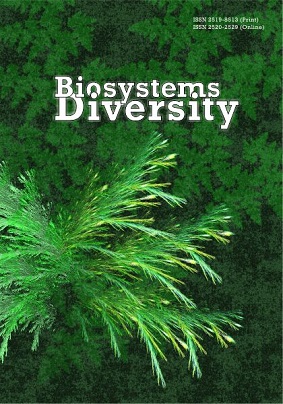Морфология и экологические особенности Sparganium × longifolium (Typhaceae) в центре Европейской части России
Morphology and ecological characteristics of Sparganium × longifolium (Typhaceae) in the Central part of European Russia
Author(s): M. P. Shilov, A. G. Lapirov, E. A. Belyakov, A. V. ShcherbakovSubject(s): Sociobiology
Published by: Дніпропетровський національний університет імені Олеся Гончара
Keywords: bur-reed; hydrid; Sparangium gramineum; Sparangium emersum; eutrophication; habitat;
Summary/Abstract: The increasing impact of anthropogenic factors and climate change affect the growth of a number of taxa of hybrid nature. These taxa are widespread among various taxonomic groups of aquatic and semi-aquatic plants. The genus Sparganium L. В is not an exception. In that regard, the aim of this study is to conduct biomorphological investigation of Sparganium × longifolium Turcz. ex Ledeb., evaluate qualitative and quantitative criteria for the hybrid similarities and differences with its parental species, as well as to analyze data on its habitat characteristics. Samples were collected in 2014–2016 from waterbodies in European Russia (Tver and Yaroslavl oblasts). In the study on biomorphology of S. × longifolium we used live and fixed materials, as well as herbarium funds of IBIW, MXA and MW. To establish and specify taxonomic features of the hybrid under study, indicating to its similarity with a certain ancestral species, our data on the morphology and ecology of S. emersum Rehm. and S. gramineum Georgi. are used. During field studies, the type of a water object where the hybrid was detected, ecological characteristics of its habitat (type of soil, depth, water temperature and pH) are determined; the list of taxa which enter into the cenosis composition is compiled. The biomorphological investigation of S. × longifolium shows that by life form this hybrid, as well as its parental species, is a vegetative-mobile evidently-polycentric annual or biennial plant of vegetative origin with a racemose root system. The following should be attributed to the characteristic features justifying the hybrid origin of S. × longifolium: 1) a wider, slightly carinated lamina (as in S. emersum); 2) a branched inflorescence (as in S. gramineum); 3) the lower covering leaf of inflorescence, often exceeding the total length of the latter; 4) fruits with a straight (as in S. emersum) as well as bent (as in S. gramineum) style. Interestingly, some populations of S. × longifolium are rich in terate forms that can be explained by back crossing with one of the parental species or pleiotropic mutation(s). It is established that S. × longifolium is not widespread in European Russia, is a typically freshwater species, occurring in the littoral zone of mesotrophic and dystrophic waterbodies (usually in lakes of glacier origin). At present, its appearance in lake ecosystems is due to accelerated eutrophication caused by increasing human activities. Perhaps earlier this hybrid formation occurred in peripheral zones of the range of S. gramineum under cyclic climate changes. Observations suggest that S. × longifolium exceeds S. gramineum in ecological potentials. At the same time, habitat features of the latter have an effect on the hybrid distribution potential (limitation of habitat spectrum) which is hardly exceed S. emersum by its ecological and coenotic characteristics.
Journal: Biosystems Diversity
- Issue Year: 25/2017
- Issue No: 2
- Page Range: 154-161
- Page Count: 8
- Language: Russian

